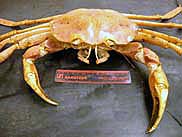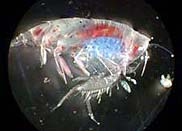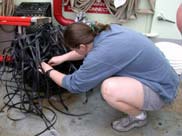|
|
|
|
|
|
|
|
|
| Sun |
Mon |
Tue |
Wed |
Thu |
Fri |
Sat |
|
|
 |
|
Q. Is the ambient water temperature around Lost City warm, attracting a large and varied fish population? Does that mean that fishing fleets or other signs of human presence impact the area? (Bill S., Saint Mary's College, Concord CA)
A. The background water is warmer than the deeper ocean water here, but it is not particularly warm (less than 50F). Even on the top of the mountain, which is at a water depth of about 2100 feet, we have not observed many fish. A few groupers routinely follow us around when we are in Alvin, and we have seen a few smaller fish, but not much else. Nutrients for larger animals are not in high abundance. The only "human" presence in the area is us, although every 2-3 days a cargo ship passes in the distance.
|
 |
|
 |
|
|
|
|
|
 |
 |
So far you’ve been hearing a lot about all the really neat carbonate and serpentinite rocks that we’ve been finding at Lost City, and a little about the chemistry of the venting waters. Both of these things have an impact on my particular area of interest, biology. My job on this cruise is to help collect and identify the macrofauna (animals larger than the size of a flea) found at Lost City. We are curious about what actually lives down there, and if any of the animals are found only at vents in the Lost City or if they are all typical deep-sea fauna. So what does live there? At first glance it doesn’t look like much does. The white rocks seem bare and the shimmering water lacks the abundant stands of animals that I am used to seeing associated with vent fluids at other hydrothermal systems that I have visited. Yet the Lost City is not devoid of life. There are many corals surrounding Lost
 |
|
Biologists take many types of samples, including this deep-sea crab. The ruler is about 5 inches (that's a big crab!)
|
City as well as the large grouper that like to follow Alvin around, and they have to be eating something. Closer inspection reveals what actually is there. Small purple fish swim lazily around and large crabs hide in cracks and crevasses.
 |
|
Some amphipods found at Lost City look very different than a "typical" amphipod. Picture taken with a Leica MZ APO stereo-microscope.
|
A few days ago Alvin pilot Anthony Tarantino was able to catch one of the crabs for us (above). Swarms of “bugs” above Poseidon are attracted to Alvin’s lights. We use a slurp gun, which functions like a little vacuum cleaner to capture these and bring them to the surface. The slurp is full of small shrimp-like creatures and other tiny crustaceans called amphipods. We haven’t seen one type of amphipod before and have taken to calling it a Frankenpod because it looks like bits of other animals all stuck together into one. Any animals that we can’t identify while at sea are preserved to allow us to easily identify them when we get back to land. Most of the animals are frozen, and back in the lab we will use their tissues for genetic comparisons to animals we know.
 |
|
Kate searches for crabs that made a home in a piece of floating debris captured by the ship.
|
Yesterday we didn’t sample any biology from Lost City because our samplers wouldn’t fit on the basket with the Beast (the large vent fluid sampler, but it was an exciting biology day anyway. Crew members fished two pieces of debris out of the ocean that had been floating along for quite some time and had been colonized by many animals during the journey. I spent much of the evening picking crabs, barnacles, and nudibranchs off of pieces of plastic strapping material and a buoy. Many of the geologists couldn’t believe that I would actually touch those things, but for me it all part of a day’s work. Getting to see all the amazing things that live in the ocean is what makes my job so enjoyable.




